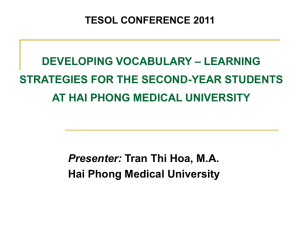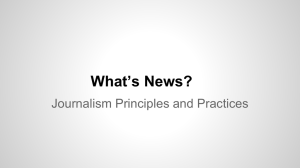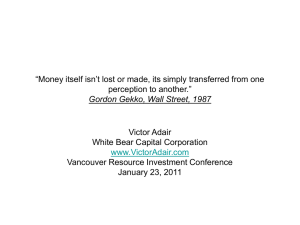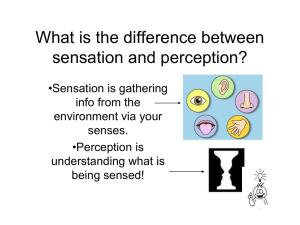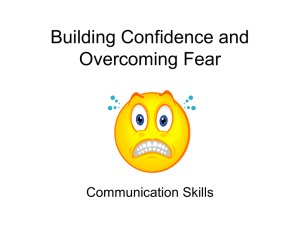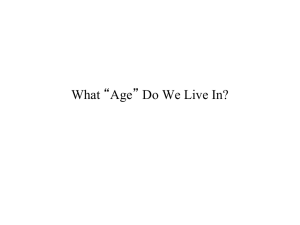Full Text
advertisement
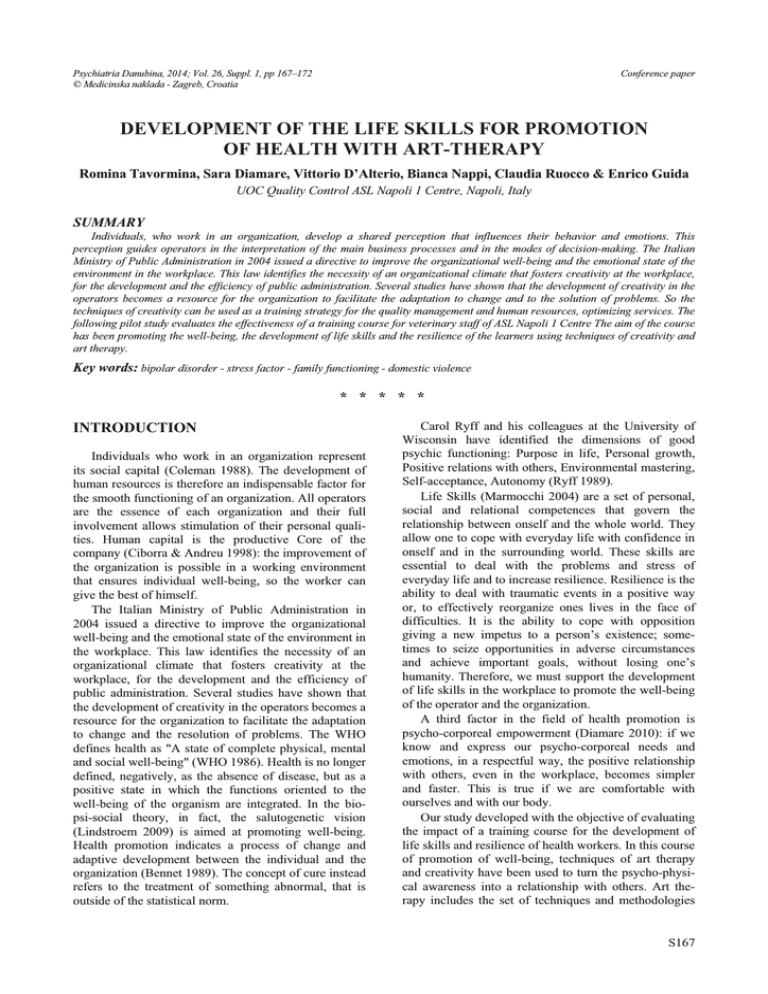
Psychiatria Danubina, 2014; Vol. 26, Suppl. 1, pp 167–172 © Medicinska naklada - Zagreb, Croatia Conference paper DEVELOPMENT OF THE LIFE SKILLS FOR PROMOTION OF HEALTH WITH ART-THERAPY Romina Tavormina, Sara Diamare, Vittorio D’Alterio, Bianca Nappi, Claudia Ruocco & Enrico Guida UOC Quality Control ASL Napoli 1 Centre, Napoli, Italy SUMMARY Individuals, who work in an organization, develop a shared perception that influences their behavior and emotions. This perception guides operators in the interpretation of the main business processes and in the modes of decision-making. The Italian Ministry of Public Administration in 2004 issued a directive to improve the organizational well-being and the emotional state of the environment in the workplace. This law identifies the necessity of an organizational climate that fosters creativity at the workplace, for the development and the efficiency of public administration. Several studies have shown that the development of creativity in the operators becomes a resource for the organization to facilitate the adaptation to change and to the solution of problems. So the techniques of creativity can be used as a training strategy for the quality management and human resources, optimizing services. The following pilot study evaluates the effectiveness of a training course for veterinary staff of ASL Napoli 1 Centre The aim of the course has been promoting the well-being, the development of life skills and the resilience of the learners using techniques of creativity and art therapy. Key words: bipolar disorder - stress factor - family functioning - domestic violence * * * * * INTRODUCTION Individuals who work in an organization represent its social capital (Coleman 1988). The development of human resources is therefore an indispensable factor for the smooth functioning of an organization. All operators are the essence of each organization and their full involvement allows stimulation of their personal qualities. Human capital is the productive Core of the company (Ciborra & Andreu 1998): the improvement of the organization is possible in a working environment that ensures individual well-being, so the worker can give the best of himself. The Italian Ministry of Public Administration in 2004 issued a directive to improve the organizational well-being and the emotional state of the environment in the workplace. This law identifies the necessity of an organizational climate that fosters creativity at the workplace, for the development and the efficiency of public administration. Several studies have shown that the development of creativity in the operators becomes a resource for the organization to facilitate the adaptation to change and the resolution of problems. The WHO defines health as "A state of complete physical, mental and social well-being" (WHO 1986). Health is no longer defined, negatively, as the absence of disease, but as a positive state in which the functions oriented to the well-being of the organism are integrated. In the biopsi-social theory, in fact, the salutogenetic vision (Lindstroem 2009) is aimed at promoting well-being. Health promotion indicates a process of change and adaptive development between the individual and the organization (Bennet 1989). The concept of cure instead refers to the treatment of something abnormal, that is outside of the statistical norm. Carol Ryff and his colleagues at the University of Wisconsin have identified the dimensions of good psychic functioning: Purpose in life, Personal growth, Positive relations with others, Environmental mastering, Self-acceptance, Autonomy (Ryff 1989). Life Skills (Marmocchi 2004) are a set of personal, social and relational competences that govern the relationship between onself and the whole world. They allow one to cope with everyday life with confidence in onself and in the surrounding world. These skills are essential to deal with the problems and stress of everyday life and to increase resilience. Resilience is the ability to deal with traumatic events in a positive way or, to effectively reorganize ones lives in the face of difficulties. It is the ability to cope with opposition giving a new impetus to a person’s existence; sometimes to seize opportunities in adverse circumstances and achieve important goals, without losing one’s humanity. Therefore, we must support the development of life skills in the workplace to promote the well-being of the operator and the organization. A third factor in the field of health promotion is psycho-corporeal empowerment (Diamare 2010): if we know and express our psycho-corporeal needs and emotions, in a respectful way, the positive relationship with others, even in the workplace, becomes simpler and faster. This is true if we are comfortable with ourselves and with our body. Our study developed with the objective of evaluating the impact of a training course for the development of life skills and resilience of health workers. In this course of promotion of well-being, techniques of art therapy and creativity have been used to turn the psycho-physical awareness into a relationship with others. Art therapy includes the set of techniques and methodologies S167 Romina Tavormina, Sara Diamare, Vittorio D’Alterio, Bianca Nappi, Claudia Ruocco & Enrico Guida: DEVELOPMENT OF THE LIFE SKILLS FOR PROMOTION OF HEALTH WITH ART-THERAPY Psychiatria Danubina, 2014; Vol. 26, Suppl. 1, pp 167–172 that utilize artistic activities such as therapeutic means aimed at the recovery and growth of the person in the emotional, affective and relational spheres. SUBJECTS The Quality Control Service has been the promoter of this study conducted on a sample of 28 operators in the Area of Veterinary Public Health of ASL Napoli 1 Centre. The course was held at the headquarters of the Veterinary Teaching Hospital. In particular, the objectives of this course have been: Promoting psycho-corporeal empowerment; Sensitizing the acquisition of a body awareness to manage communication; Learning from the experience of other people to raise the awareness of sharing (multidisciplinary and trans-professional) common goals; Developing resilience; Supporting the development of a safe and healthy work environment and supporting the activities of health promotion of the staff; Promoting well-being. METHODS The teaching method was composed by frontal lessons (for 30% of the course) and by experiential workshops (for 70% of the timetable) and it used techniques of Dance Movement Therapy, Music Therapy and theater-Therapy. We used, in particular, the method EEICC©, Creative Conscious Embodied Aesthetic Experience (Diamare 2011), that is an innovative method of learning of art, of exploration of the talents, of creative development and of well-being on the whole. This method, by the modulated perception of a work of art and by the psychosomatic process of reflection, allows persons to experience creative solutions to interpersonal difficulties. The name, chosen for this method, comes from the "Aesthetic Experience" by Vezio Ruggieri (Ruggieri 1997) and "embodied simulation" by Vittorio Gallese (2005). The EEICC® uses empathy as a resource through a route of corporeal reappropriation and imitative decoding of a work of art. This method allows the recovery of history and culture by the sharing of pathos expressed in the work of art. The effects of this method are the expansion of the imaginative capacity and the exploration of new potentiality. The EEICC combines various methods: visualization techniques, stimulation of imagination, techniques of reworking gesture of aesthetic perception and of emotional experience. This method has been proposed in the setting of "Salons of Well-being" (Diamare 2009), arranged during public events in the streets of the city of Naples or in Hospitals Health Promoting Hospitals Network. S168 Evaluation of the course For the evaluation of the training course the following tests were administered, in ex-ante and expost: Body Perception (Ruggieri 1993), a psycho-physiological test used to assess the perception of the body of individuals. This test assigns numerical values to the possible perceptual nuances of the various parts of the body. Psychological Well-Being PWB, a self assessment questionnaire, of 84 items, to measure the dimensions of psychological well-being standardized in the Italian version (Ruini 2003); the Life Skills are grouped into six dimensions that underline important aspects of personality necessary to define the presence of psychological well-being: 1) self-acceptance: having positive attitudes towards themselves; 2) positive interpersonal relations: establishing confident relationships based on trust, warmth and feelings of empathy: 3) autonomy: being self-confident and independent, that is the ability to resist social pressures that tend to act and/or think like the majority of other people; 4) environmental mastering: having expertise in controlling the surrounding environment and the ability to handle a wide range of activities and to take all the opportunities that the social environment and context could offer to us; 5) purpose in life: having goals and a sense of direction towards life. In addition, it develops the beliefs that gives a real meaning to our lives: 6) Personal Growth: getting the feel of continued growth and expansion. Being prepared to change and, therefore, being opened to new experiences for realizing our potential and achieving a higher understanding of ourselves. In our study we have evaluated the hypothesis of a positive correlation between the perception of the body and the dimensions of well-being considered; that is to determine whether, at the end of the path, if the improvement of one corresponds to an amelioration of others. RESULTS Descriptive analysis data of PWB Data of PWB are here described analytically to evidence eventual variations before and after the course. In the administration of the test, the parties shall state their degree of agreement with the statements contained in items, using a Likert scale from 1 to 6, where 1 = disagree; 6 = totally agree. Negative items are counted in reverse order, so that the final score is the self-assessment of the subject to that scale. Romina Tavormina, Sara Diamare, Vittorio D’Alterio, Bianca Nappi, Claudia Ruocco & Enrico Guida: DEVELOPMENT OF THE LIFE SKILLS FOR PROMOTION OF HEALTH WITH ART-THERAPY Psychiatria Danubina, 2014; Vol. 26, Suppl. 1, pp 167–172 The total score of each scale is calculated by summing the degree of agreement of each item, so it potentially varies from 14 to 84. The raw data were then compared with the normative data (Ruini 2003) presented in Table 1 and Table 2 shows the averages calculated for the 28 subjects, for the 6 dimensions. Table 1. Ranges of dimensions by gender Normative Data Males Females Self-acceptance 50.15-74.33 43.53-71.67 Positive Relations 51.54-74.30 51.96-74.88 Autonomy 54.15-73.79 51.99-72.51 Environmental control 48.51-69.89 45.27-67.29 Purpose in Life Personal Growth 53.52-74.14 54.08-73.10 48.59-70.81 51.27-71.75 Table 2. Changes in dimensions over the study Dimensions Ex ante Ex post Ex ante Ex post of Well-being Males Males Females Females Self-acceptance 58.72 64.64 58 62.29 Positive Relations 58.09 63.64 66.18 67.06 Autonomy 63.18 63.36 63.41 62.35 Environmental control 62.90 60.18 60.41 62.94 Purpose in Life 63 63.46 63 63.47 Personal Growth 61 62.46 67.41 68 The legal range is divided into genders and, below, we report the results of the comparison between the raw data and the normative framework, in the following descriptions of the dimensions of the well being with the relevant graphs (Figure 1, Figure 2). 1. Self-acceptance: in this items the score, still 2. 3. 4. 5. 6. remaining in the standard level, increases at the end of the course. Positive Relations: the score, still in accordance with the standard level, increases at the end of the course. Autonomy: The score remained normal before and after the course. Environmental Control: the score still remaining in the standard level, decreases slightly at the end of the course. Purpose in Life: The score remained in the standard before and after the course. Personal Growth: the score, still in accordance with the standard level, increases slightly at the end of the course Figure 1. Psychological Well-being in the group of males 1. Self-acceptance: the score, still in accordance with the standard level, increases at the end of the course. 2. Positive Relations: the score, still in accordance 3. 4. 5. 6. with the standard level, increases slightly at the end of the course. Autonomy: the score, although it remained in the standard level, it decreases slightly at the end of the course. Environmental Control: the score, still in the normal level, increases slightly at the end of the course. Purpose in Life: the score remains almost unchanged in the standard. Personal Growth: the score remains almost unchanged in the standard. Figure 2. Psychological Well-being in the group of females DISCUSSION Let us examine, below, some differences which emerged from the administration of the test PWB, ex ante and ex post in the training course, for veterinarians divided according to their gender. From the analysis of raw data, compared with these norms, the group of males at the beginning of the course is oriented to a discrete control over their surroundings. They also have got a good ability to realize specific goals through an autonomous way of thinking and acting. This group, compared to the women’s one, is S169 Romina Tavormina, Sara Diamare, Vittorio D’Alterio, Bianca Nappi, Claudia Ruocco & Enrico Guida: DEVELOPMENT OF THE LIFE SKILLS FOR PROMOTION OF HEALTH WITH ART-THERAPY Psychiatria Danubina, 2014; Vol. 26, Suppl. 1, pp 167–172 less susceptible to change and has got lower self acceptance and relational openness. After the course, men show a greater self-acceptance and an improvement of relationships based on a greater empathy towards others and they showed a decrease of control over their surroundings, while the values of the other items remains unchanged. At the beginning of the course, on the contrary, the women's group presents a framework with scores slightly better than the group of males. They in fact, are more likely to change and to manage their personal growth and they are firm in their beliefs; women manifest also a good ability to control and to manage their surrounding environment. This quality improves slightly at the end. A slight increase, after the course, concerns the dimension of self-acceptance and positive relations with other people, and also a greater permeability to the influence of expectations and judgments of the others. In conclusion, the group of men has presented the most relevant changes, compared to the women’s group, in the dimensions of self-acceptance and positive relations. Conversely the women's group, starting from a better position at the beginning of the course, did not present significant changes at the end of the training course. As regards the evaluation of the data of Test Body Perception refer to the statistical analysis described below. Data Analysis In order to assess the effects of the training course on Life Skills, we have analysed data from the Body Image Perception Test and Ryff’s Psychological WellBeing Scales (PWB) collected ex-ante and ex-post the training course. Given that the data are measured on an ordinal scale rather than an interval scale the standard parametric techniques, such as t–tests, are not applicable; In our case nonparametric statistical tests are appropriate for such comparisons. For interval–scale data, the mean is the generally–accepted measure of central tendency. For ordinal–scale data, in contrast, the notion of mean is meaningless; rather, the median is the usual measure of central tendency. Both for the Body Image Perception Test and for the Psychological Well-Being Scales, we have a number of paired comparisons leading to a series of differences, some of which may be positive and some negative. The appropriate methods for testing the significance of the difference of the means in this case is the Wilcoxon signed-rank test (Wilcoxon 1945). The Wilcoxon signed-rank test is a non-parametric statistical hypothesis test used when comparing two related samples, matched samples, or repeated measurements on a single sample to assess whether their population mean ranks differ (i.e. it is a paired difference S170 test). It can be used as an alternative to the paired Student’s t-test, t-test for matched pairs, or the t-test for dependent samples when the population cannot be assumed to be normally distributed. The Wilcoxon signed rank test consists of five basic steps: 1) State the null hypothesis (the null hypothesis is that both distributions are the same) and, in particular, the hypothesized value for comparison. 2) Rank all observations in increasing order of magnitude, ignoring their sign. Ignore any observations that are equal to the hypothesized value. If two observations have the same magnitude, regardless of sign, then they are given an average ranking. 3) Allocate a sign (+ or –) to each observation according to whether it is greater or less than the hypothesized value (as in the sign test). 4) Calculate: R+ = sum of all positive ranks; R– = sum of all negative ranks; R = smaller of R+ and R–. 5) Calculate an appropriate P value. The P value is the probability of observing a difference equal or more extreme to what was actually observed, if the nullhypothesis is true. The P value is usually considered to be significant at 0.05 level but is an arbitrary choice in origin. A result considered as statistically significant when its P value is less than 0.05. Consequently, we reject the null-hypothesis. Note that the smaller the P value, the stronger the evidence against null-hypothesis. Table 3 shows the values of the Wilcoxon signedranks test with the associated P value for the body image perception test. Note that the body parts statistically significant are: front body perception (left part); front body perception; total body perception. In other words, there is some evidence to suggest that there is a difference between the values of this body parts after and before the training course beyond that expected by chance. Regarding the Psychological Well-Being Scales (PWB), only the self-acceptance dimension is statistically significant (p-value=0.008), the other dimensions aren’t statistically significant. We analysed also, using the rank correlation coefficient of Spearman, the possible correlation between the perception of the Total Body (Body Perception Test) and the size of the test PWB which concerns the improvement of relations with other people. Analysis of data shows a positive correlation, corresponding to 0.005 (Sig. (2-tailed)), which represents an interdependence between these two variables described before. At the augmentation of one of them corresponds to an increase of the other one. (Table 4). This non-parametric correlation appeared statistically significant to give life to new ideas for further research. Romina Tavormina, Sara Diamare, Vittorio D’Alterio, Bianca Nappi, Claudia Ruocco & Enrico Guida: DEVELOPMENT OF THE LIFE SKILLS FOR PROMOTION OF HEALTH WITH ART-THERAPY Psychiatria Danubina, 2014; Vol. 26, Suppl. 1, pp 167–172 Table 3. Values of the Wilkoxon signed-rank test with the associated P value for the body image perception test Front Body Front Body Back Body Back Body Front Body Back Body Total Body Perception Perception Perception Perception Perception Perception Perception (Right Part) (Left Part) (Right Part) (Left Part) (a) (a) (a) (a) Z -2.175 -2.972 -1.658 -1.845 -2.790(a) -1.731(a) -2.824(a) P Value 0.030 0.003 0.097 0.065 0.005 0.083 0.005 a - Based on negative ranks Table 4. Nonparametric Correlations Spearman's rho Body Perception Ex-Post PWB Relation Positive Ex-Post Correlation Coefficient Sig. (2-talled) N Correlation Coefficient Sig. (2-talled) N Body Perception Ex-Post 1.000 28 0.534* 0.005 26 PWB Relation Positive Ex-Post 0.534* 0.005 26 1.000 26 * Correlation is significant at the 0.01 level (2-talled) CONCLUSIONS Acknowledgements According to the Statistical analysis of the data, relating to the Body Perception, it is clear that our subjects examined have experienced, after the training course, an increase in the overall perception of their own body, in particular of the front and left front. The front part of the body, that we show with an increased awareness and with which we easily identify, represents the communication with other people at the present moment. The back side of ourselves, less visible in a direct way, represents a less well-known part of us, the most obscure one: what is behind us, that in the language of analogy, represents the past. Therefore, the improvement of perception of the front part of the body means that corporeal awareness of elements of it, more related to the conscious image of themselves in the relationships with the others, is improved. The front left side of the body, seat of the "heart" and of all its emotive valences, is governed by the right hemisphere of the brain. It is symbolically linked to creativity and to gestural expressions stimulated by our training through the techniques of art therapy. The perception of the body (anterior-sin., Front, global) increases significantly. In parallel by the PWB test we deduced that the dimension of self acceptance increases too: a greater perception and awareness of the body is, for all of us, at the base of a greater self-acceptance of ourselves as a single person (Lowen 1979). In conclusion, the process of psycho-corporeal empowerment and art-therapies used here, in a strictly didactic setting, addresses our operator's attention to the perception of the body in favor of a greater self acceptance. They allow one to modulate, through play, art and dance, emotional experience in "gestural containers". These routes cross the body and activate a greater awareness in relation with each other. dr. Caputo Vincenzo, Coordinator of Veterinary Public Health – ASL Naples 1 Centre Prof. Ruggieri Vezio, La Sapienza University of Rome - Chair of Psychophysiology Prof. Alfonso Piscitelli, Researcher of Social Statistics - University of Naples Federico II Conflict of interest: None to declare. References 1. Antonovsky A: Health, Stress, and coping. S. Francisco: Jossey-Bass, 1979. 2. Baker LF: L’uomo nella trappola. Ed. Ambrosiano, Roma. 1973. 3. Bellia V: Dove danzavano gli sciamani. Setting in danzaterapia. Magi, Roma, 2000. 4. Bennet N: Stress among employee assistance program administrators:the influence of role and organizational characteristics. J Drug Issues 1989; 19:403-18. 5. Bertini M: Psicologia e salute, Nuova Italia Scientifica, Roma, 1984. 6. Bertini M: Le dimensioni del Ben-essere psicologico: nuove prospettive nella qualità della cura, Conferenza Nazionale HPH, Milano 16 Ottobre, 2008. 7. Bossolasco M: Stress, emozioni, immunità e malattia. Firenze: Psico LAB, 2003. 8. Butto N: Medicina Universale e il settimo Senso, Edizioni Mediterranee, Roma, 2004. 9. Ciborra C & Andreu R: Organizational learning and core capabilities development: the role of it. In Galliers, R. D.; Baets, W. R. J. (Ed.). Information technology and organizational transformation: innovation for the 21st century organization. Chichester: John Wiley & Sons, 1998. 10. Clark KB & Fujimoto T: Product Development Performance, Harvard Business School Press, Boston, 1991. 11. Cohen MD, Bacdayan P: Organizational Routines Are Stored as Procedural Memory: Evidence from Laboratory S171 Romina Tavormina, Sara Diamare, Vittorio D’Alterio, Bianca Nappi, Claudia Ruocco & Enrico Guida: DEVELOPMENT OF THE LIFE SKILLS FOR PROMOTION OF HEALTH WITH ART-THERAPY Psychiatria Danubina, 2014; Vol. 26, Suppl. 1, pp 167–172 12. 13. 14. 15. 16. 17. 18. 19. 20. 21. 22. 23. 24. 25. 26. 27. 28. Study, in Cohen M.D., Sproull L.S., eds., Organizational Learning, SAGE, Thousand Oaks, London, 1996. Coleman J: The Foundations of Social theory, Cambridge MA: Harvard University Press, 1990. Coleman J: Social capital in the creation of human capital. American Journal of Sociology 1988; 94:95-120. Cherniss C: La sindrome del burn-out Centro Scientifico Torinese, Torino, 1983. De Vera d’Aragona P: Curarsi danzando. Ed. RIZA Scienze, Milano, 1986. Desoille R: Teoria e pratica del sogno da svegli guidato, Roma, Astrolabio, 1974. Diamare S: La creazione consapevole nuovo metodo didattico di EEICC®, pag. 65; Se lo conosci lo affronti, pag. 75; Dal sacro al profano al Sacro EEICC®, pag. 136; La danza: l’ombelico del mondo, pag. 141, Atti al XXIII Congresso Nazionale SIMP, Parma 19-22 Maggio, 2011. Diamare S, Pocetta G, Polito G: Empowerment psicocorporeo come strategia di BenEssere e prevenzione del burn out nei servizi di cura», in Rivista Educazione Sanitaria e Promozione della Salute n. 4, 2010, pag. 390 a 404. Diamare S, Polito G: La prevenzione del Burn-out e la gestione del rapporto operatore paziente, libro degli Abstract del VIII Congresso Nazionale La Salute Come Responsabilità Sociale Condivisa”, 1-2-3-4 Ottobre, 2008, pag 266 a cura della S.I.P.Sa, Rovigo Diamare SG, Polito ML, Pasquarella G, Pocetta D’Agostino ML, Montella R: Studio della dimensione corporea nella promozione della salute: verso una semeiotica dell’atteggiamento psicomotorio, Atti della XI Conferenza Nazionale di Sanità Pubblica, 15-17 ottobre 2009, Napoli pag.588 Ed. Iniziative Sanitarie Diamare S: Il tempo delle mele: Salotti del Benessere Regione Campania, Assessorato all’Agricoltura ed alle Attività produttive, 2009. Diamare S, Montalto M: Curarsi con le immagini. Un percorso originale per accrescere la fiducia in se stessi, La nuova Tecnica per eliminare insicurezza e ansia”, Ed. Riza Scienze Gennaio, 2011. Druss RG: The psychology of illness: in sickness and in health. American Psychiatric Press, Washington D.C., 1995. Engel: The need for a new medical model: A challenge for biomedicine in Science 1977; 196:129-136. Frigoli D, Masaraki G, Morelli R: Verso la concezione di un Sé psicosomatico. Milano, Cortina, 1980. Gallese V: Embodied simulation: From neurons to phenomenal experience. Phenomenology and the Cognitive Sciences 2005; 4:23–48. Lindstroem B, Erikson M: Contestualizing salutogenesis and Antonovski in Public Healthdevelopment. Health Promotion International 2006; 2:238-244. Lindstroem B, Erikson M: The salutogenic approach to the making of HiAP/healthy public policy: illustrated by a case study. Global Health Promotion 2009; 16:17-28. Correspondence: Dr. Romina Tavormina, Psychologist viale Leone, 4/F, 80055 Portici (NA), Italy E-mail: romina.tavormina@libero.it S172 29. Litwin GH, Stringer R: Motivation and Organizational Climate. Harvard University press, Cambridge, 1968. 30. Lowen A: Il linguaggio del corpo. Ed. Feltrinelli, Milano. 1978. 31. Lowen A: Espansione ed integrazione del corpo, in Bioenergetica. Ed. Astrolabio, Roma, 1979. 32. Malslach C: La sindrome del burn-out Cittadella, Assisi, 1992. 33. Marmocchi P, Dall’Aglio C, Tannini M: “Educare le Life Skills. Come promuovere le abilità psico-sociali e affettive secondo l’Organizzazione Mondiale della Sanità, ed. Erickson, Trento, 2004. 34. Morelli U: Mente e bellezza, Umberto Allemandi & C, Torino, 2010. 35. Nelson DL, Simmons BL: Health psychology and work stress: a more positive approach. In: Quick Campbell J, Tetrick LE eds.Handbook of occupational health psychology. Washington: American Psychological Association 2003; 97-119. 36. Parker CP, Baltes BB, Young SA, Huff JW, Altmann RA, Lacost HA, Roberts JE: Relationships between psychological climate perceptions and work outcomes: a metaanalytic review. Journal of Organizational Behaviour 2003; 24:389-416. 37. Panzarani R: Gestione e sviluppo del Capitale Umano. Le persone nel Bilancio dell'Intangibile di una organizzazione. Franco Angeli Editore, Milano, 2004. 38. Reich W: Analisi del carattere. Ed. Sugar, Como, 1989. 39. Rossati A: Burn-out: l’esaurimento da stress degli operatori dei servizi sanitari. Psicologia Italiana Notizie, 1985, n.2/3. 40. Ryff CD: Happiness is everything, or is it? Exploration on the meaning of psychological wellbeing. J. of Personality and Social Psychology 1989; 57:1069-81. 41. Ruggieri V, Galati D, Lombardo G: Processi di costruzione dell’immagine corporea. Realtà e prospettive in psicofisiologia 5-6-7, 71- 89, Maggio 1993. 42. Ruggieri V: L’esperienza estetica, Fondamenti psicofisiologici per un’educazione estetica, Ed. Armando, Roma, 1997. 43. Ruggieri V: L’identità in Psicologia e teatro, Edizioni Scientifiche Ma.Gi. s.r.l., Roma, 2001. 44. Ruini C, Ottolini F, Rafanelli C, Ryff C, Fava GA: La validazione italiana delle Psychological Well-being Scales (PWB), Rivista di psichiatria 2003; 38:117. 45. Schilder P: Immagine di sé e schema corporeo, Franco Angeli Editore, Milano, 1973. 46. Schneider B: The people make the place. Personnel Psychology 1987; 40:437-53. 47. Wilcoxon F: Individual comparisons by ranking methods. Biometrics bulletin 1945; 1:80-83. 48. VHO, The Ottawa charter for health promotion, Geneve, 1986. 49. Zimmerman MA, Rappaport J: Citizen participation, perceived control, and psychological empowerment. In American Journal of Community psychology 1988; 5:725-750.



